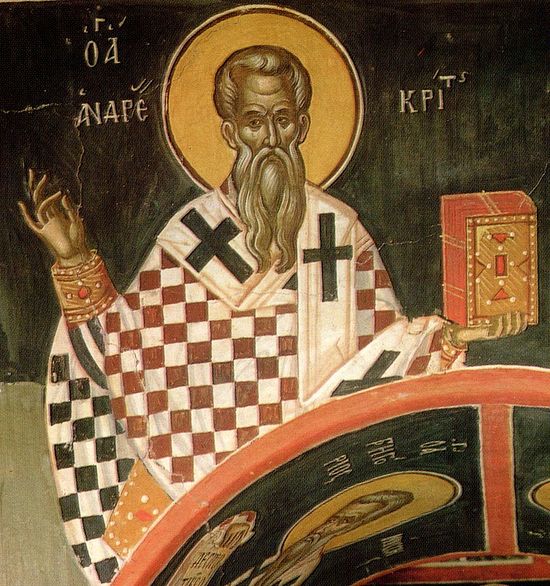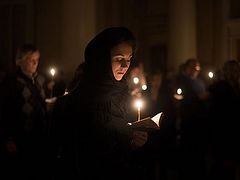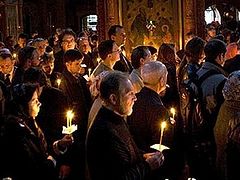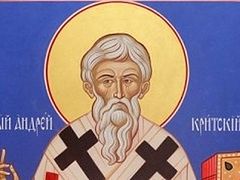St. Andrew of Crete left a deep mark on Orthodox tradition as a great saint, as a theologian, and as a remarkable hymnographer.
Comparatively little is known about him. He was born about the year 660. He came from Palestine. In his youth, he renounced the world and left for the Lavra of St. Savva. Then he wound up in Constantinople, where he held the position of orphanotroph, that is, the administrator of orphanages. In this position, he was renowned for his acts of charity and mercy. Around 712, he became bishop of Crete. His Life reports that it was thanks to his prayers that the island of Crete was saved from Arab invasion. The saint departed to the Lord around 740. The memory of St. Andrew of Crete is celebrated on July 4/17.
To his pen belong a number of homilies on the feasts of the Lord and the Theotokos and on other occasions. For his time, he was an outstanding and eloquent preacher. But he gained the greatest fame as a hymnographer—the author of stichera and canons. Contrary to the opinion of some, he was not the first to begin to write full canons (there were earlier canons from the sixth-seventh centuries that have come down to us in Georgian translation in the collection Iadgari), however, he is the first famous author of full canons, which have come down to us in the Greek language.
He began his hymnographic activity with the three-ode canons that he composed for every day of Holy Week, except Saturday; they used to be sung at Matins from Monday to Friday, then the works of St. Cosmas Maiuma were joined to them, and then the works of St. Cosmas pushed the three-ode canons of St. Andrew to Compline. St. Andrew wrote full canons that are still used in the Divine services: the Great Canon, for Lazarus Saturday, the Sunday of the Myrrh-bearing Women, Mid-Pentecost, and the Nativity of the Theotokos. He also wrote canons that are now unused: for Palm Sunday, Pascha, Theophany, the Meeting of the Lord, the Elevation of the Cross, the Martyr Trophimus (July 23/August 5), and the Maccabean Martyrs (August 1). A peculiarity of all these canons mentioned is the presence of a second ode, based on the mournful and formidable song of Moses from Deuteronomy 32, a large number of troparia, and a Triadicion (a hymn dedicated to the Holy Trinity) and Theotokion (a troparion to the Most Holy Theotokos) at the end.
St. Andrew had a characteristic special stylistic handwriting, a special system of images, often going off into early-Christian Palestinian archaisms; for example, the image of Christ’s side as a chalice (Great Canon, Ode 4); his style is concise, strict, and didactic, and his simple language is immediately recognizable.
St. Andrew of Crete is best known for his Great Canon, or Canon of Repentance. There exists an opinion that it was originally just a number of troparia without irmosi and without Theotokia, and only later did Joseph the Hymnographer arrange it. Modern knowledge of Palestinian hymnography shows that this view is incorrect. The Great Canon is originally a complete work. Only the troparia dedicated to St. Andrew of Crete himself and St. Mary of Egypt are later (although, judging by the life written by St. Sophrony of Jerusalem, her memory could have been celebrated quite early)—all the rest belong to St. Andrew. The earliest manuscript attesting to the Great Canon (with a slightly different order of troparia and a shorter composition) is the Studite Triodion of the middle of the second half of the ninth century, stored in the library of the Academy of Sciences in St. Petersburg. This manuscript has the Canon in hits original place in the services of Great Lent—at Matins of Thursday in the fifth week (when the life of St. Mary of Egypt is read). Only later does it also appear at Compline of the first four days of the first week.
The Canon is a soul-piercing, heartfelt lament of the righteous for his sins. The very beginning: “Where shall I begin to weep for the action of my wretched life? What first-fruit shall I offer, O Christ, in this my lamentation? (Ode 1)—attunes the soul for mourning and repentance, for the “wounding of the heart.”
The author of the Canon laments not only for himself, but for all mankind that has sinned. He recalls every transgression, every fall, from Adam to the New Testament. The majority of the Canon—eight odes—consists of Old Testament examples. St. Andrew doesn’t just recall the sins of the forefathers, but he experiences them as his own: “I have rivaled in transgression Adam the first-formed man, and I have found myself stripped naked of God” (Ode 1).
The transgressions of the forefathers become prototypes of the passions that torment a man: “Instead of the visible Eve, I have the Eve of the mind: the passionate thought in my flesh” (Ode 1). Or another example: “To whom shall I liken thee, O soul of many sins? Alas! To Cain and to Lamech. For thou hast stoned thy body to death with thine evil deeds, and killed thy mind with thy disordered longings (Ode 2: “See now, see”). Here St. Andrew follows St. Maximus the Confessor, for whom Cain is “the acquisition, the law of the flesh,” rising up against Abel, that is, the mind, according to the symbolic interpretation, and killing him. This is what St. Maximus writes: “Had Abel kept guard over himself and had he not gone out with Cain into the field, that is, into the plain of natural contemplation, before attaining dispassion, then Cain, who is and is called the law of the flesh would not have risen up and killed him” (Ad Thalassium 49).
If in the Canon St. Andrew recalls examples of Old Testament and New Testament righteousness, then it is first of all in order to reproach his soul for sloth and for sinfulness and to call it to imitation, for example: “O miserable and wicked soul, imitate the righteous and pure mind of Joseph; and do not live in wantonness, sinfully indulging thy disordered desires” (Ode 5).
The Canon is a broad historical panorama outlining the history of human sin and human righteousness, of the rejection and acceptance of God. The contents of the Canon are deeply Christ-centered, with heartfelt appeals to Christ in every ode, for example: “May the Blood from Thy side be to me a cleansing fount, and may the water that flows with it be a drink of forgiveness. May I be purified by both, O Word, anointed and refreshed, having as chrism and drink Thy words of life” (Ode 4). The only way of purification for St. Andrew is in Christ, through sobriety, podvig, and deed—to the vision of the Divine.
The Great Canon of St. Andrew is, undoubtedly, based on a robust Patristic foundation, with quotes from St. Meletius of Sardis, St. Ephraim of Syria, St. Gregory the Theologian, St. Gregory of Nyssa, and St. Maximus the Confessor. And the merit of St. Andrew of Crete is that he was able to synthesize their experience and imprint it into the Canon.
Sometimes you hear the view in Church-related circles that St. Andrew of Crete himself supposedly experienced all the sins he writes about in the Canon, otherwise he wouldn’t have been able to narrate them with such force and persuasiveness. Few things could be more ridiculous and blasphemous than such a judgment! A saint is a saint because he feels that he is the greatest sinner, not being one in fact; the visitation of Divine grace makes the smallest blemishes on his conscience terrible and repugnant to him, and he laments his smallest transgressions as great falls. The aforementioned opinion is a kind of reflection of the vulgar pseudo-wisdom of everyday life: “You have to experience everything yourself to understand it.” Not necessarily…
What is given to us in the Canon of Repentance of St. Andrew of Crete is the Biblical, ecclesiastical, truly universal experience of repentance, of the stinging of the heart, of the excruciating removal of the old, dead man and the putting on of the New Adam, in Christ Jesus, our Lord, to Whom glory is due unto the ages.




